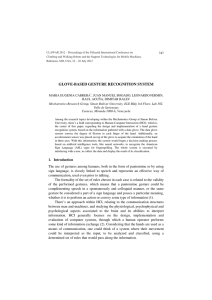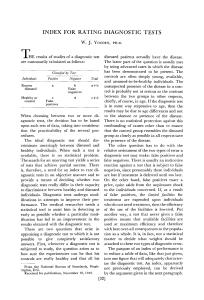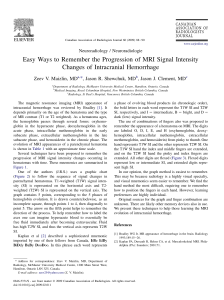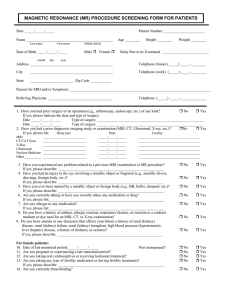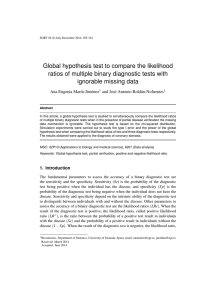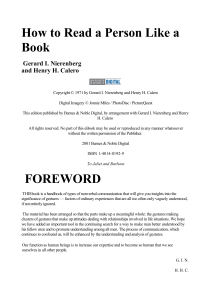Combining Mobile Devices and Workstations for the Reading of
Anuncio
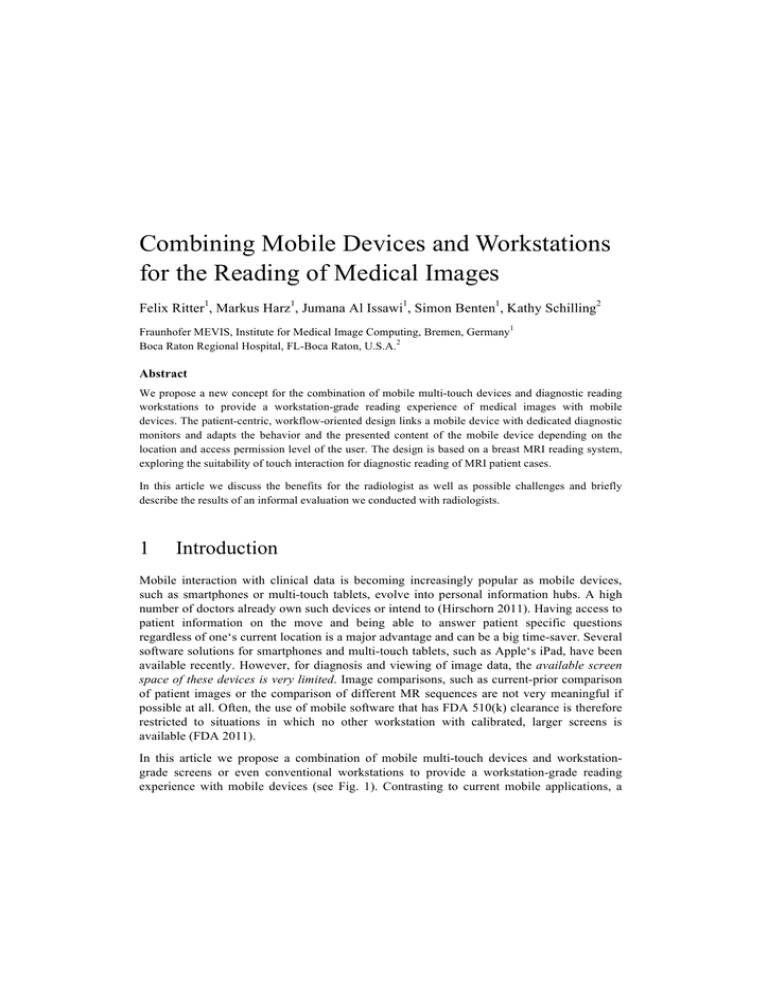
Combining Mobile Devices and Workstations for the Reading of Medical Images Felix Ritter1, Markus Harz1, Jumana Al Issawi1, Simon Benten1, Kathy Schilling2 Fraunhofer MEVIS, Institute for Medical Image Computing, Bremen, Germany1 Boca Raton Regional Hospital, FL-Boca Raton, U.S.A.2 Abstract We propose a new concept for the combination of mobile multi-touch devices and diagnostic reading workstations to provide a workstation-grade reading experience of medical images with mobile devices. The patient-centric, workflow-oriented design links a mobile device with dedicated diagnostic monitors and adapts the behavior and the presented content of the mobile device depending on the location and access permission level of the user. The design is based on a breast MRI reading system, exploring the suitability of touch interaction for diagnostic reading of MRI patient cases. In this article we discuss the benefits for the radiologist as well as possible challenges and briefly describe the results of an informal evaluation we conducted with radiologists. 1 Introduction Mobile interaction with clinical data is becoming increasingly popular as mobile devices, such as smartphones or multi-touch tablets, evolve into personal information hubs. A high number of doctors already own such devices or intend to (Hirschorn 2011). Having access to patient information on the move and being able to answer patient specific questions regardless of one‘s current location is a major advantage and can be a big time-saver. Several software solutions for smartphones and multi-touch tablets, such as Apple‘s iPad, have been available recently. However, for diagnosis and viewing of image data, the available screen space of these devices is very limited. Image comparisons, such as current-prior comparison of patient images or the comparison of different MR sequences are not very meaningful if possible at all. Often, the use of mobile software that has FDA 510(k) clearance is therefore restricted to situations in which no other workstation with calibrated, larger screens is available (FDA 2011). In this article we propose a combination of mobile multi-touch devices and workstationgrade screens or even conventional workstations to provide a workstation-grade reading experience with mobile devices (see Fig. 1). Contrasting to current mobile applications, a Combining Mobile Devices and Workstations for the Reading of Medical Images 232 highly increased display space and processing power is paired with a more natural and direct interaction on image data, as well as a higher mobility and location awareness when compared to current workstations. All diagnostically relevant image data will be presented on large, calibrated screens. The mobile device may display secondary information, such as anamnesis, patient history, genetic predisposition and even control the patient selection but is never used to display patient images for diagnostics. Interaction with the data is controlled via multi-touch gestures on the multi-touch tablet or smartphone. We will show some new approaches that go beyond the limits of mouse and keyboard and demonstrate the potential for increased interaction performance. The concept is applied to diagnostic reading of breast MRI series, however, potential applications spread beyond. Figure 1: Pairing a mobile device with a workstation (left) or a large screen for diagnostic reading (right) 2 Current state oft he art We note a high demand for reading software on mobile devices, reflected in a growing number of presentations at RSNA 2011, and also reflected by company efforts to support their respective clinical software platforms on mobile devices. Based on the current display quality of mobile devices, the FDA limits the diagnostic reading of patient images on mobile devices to high-contrast, low-resolution images (SPECT, PET, CT, and MRI), which excludes most X-ray and mammography images. The latest generation of mobile devices with high-resolution displays will accommodate much finer detail but still requires panning a mammography or computed radiography in order to inspect and perceive all details. Because most mobile devices adapt themselves to changes in lighting conditions, calibrating the display and maintaining a calibration is difficult. Currently, FDA-approved mobile applications may therefore only be used when there is no access to a workstation (FDA 2011). That said, only very few medical applications have been approved for diagnostic reading. To our knowledge, all these applications use the screen of the mobile device to display the image data directly. None of them integrates the mobile device into the reading process of the workstation. Combining Mobile Devices and Workstations for the Reading of Medical Images 3 233 What issues do current workstations have? Conventional workstations for image reading, such as breast MRI workstations in this case, support the viewing of patient images from fitting modalities, the navigation within the images, the marking, annotation, or quantification of findings and structures, as well as the generation of reports that summarize the reading results. Despite providing powerful image analysis methods for automatic quantification and computer-aided detection, the most important aspect is to display patient images efficiently. Most workstations are sold as a combination of hard- and software for one specific purpose, such as the diagnostic reading of MRI breast images. Due to cost and space limitations, they are usually bound to a fixed location in the hospital and are not available at every place. „Mobile“ access to the reading software could be accomplished by two very different approaches: • Providing multi-purpose workstations with one or two big screens at many locations within the hospital; instead a whole software suite of applications would support a multitude of different diagnostic tasks at these workstations • Providing each doctor with a mobile device that supports their very specific tasks Having multi-purpose workstations present at many different places would indeed solve the accessibility issue. Still, specialized input devices, such as special keypads for mammography reading applications, would not be available automatically due to the same limitations. A highly customizable input device that configures itself to personal preferences could be very beneficial here. It could also collect and provide additional information, such as a history of cases recently viewed, regardless of a specific application. Such an input device would be mobile, personal, and connectable to a workstation wherever required. A different challenge workstations pose to the user is the underlying interaction design and information visualization concept, which is often strongly affected by the engineering perspective of software design and overloaded with user interface elements providing random access tools. While working with radiologists we noticed that only very few tools are used, despite having more powerful analysis methods at their disposal. Functions or interface elements can either not be found because they are too small or hidden, their purpose is not understood, or they are redundant. By offloading secondary information or status indicators onto an interaction device with a display, the screen provides even more distraction free real estate for the patient images. Only the most important information has to be visible on the reading screens. In other words, a multitouch tablet device would be the perfect companion for these multipurpose workstations. Combining Mobile Devices and Workstations for the Reading of Medical Images 4 234 What issues do current mobile applications have? With our concept we want to avoid possible disadvantages of mobile applications as standalone reading devices. As described by Albinsson and Zhai (2003) one limitation while interacting with mobile devices is the user’s fingers, hands, or arms blocking part of the screen and thus in medical context, blocking part of diagnostically relevant information. This is particularly impractical when doctors discuss images with either their patients or colleagues. Users have to execute a gesture and then remove their hands to uncover the mobile devices’ screen to be able to read the data correctly. Beside the occlusion of the screen, high precision interaction with the human finger becomes an issue when users select targets that are smaller than their fingers (Albinsson & Zhai 2003). Various applications emulate mouse interaction. When a measurement is performed the users choose start and end point by tapping on each target. However, if the target is too small users have to zoom in first to be able to choose each point precisely. Instead, a variety of potential, more flexible finger gestures to reduce the number of required steps could be used. Furthermore, in discussions with radiologists it became clear that too small to accommodate multiple images or additional image distribution of contrast agent over time). This results in the users relevant image data at a glance, but having to switch between overview of all relevant data. 5 mobile device screens are data such as graphs (e.g. not being able to view all different views to get an What’s the benefit of using mobile devices in combination with stationary displays for reading medical images? 5.1 Overcoming the one-finger interaction So far, the majority of first generation mobile applications for the inspection of medical images did not introduce interaction styles beyond basic gestures, such as the pinch gesture for magnification. However, using fingers to grab, to measure, to fold, or to annotate may be easier to operate despite our long-term training towards „masters of the mouse“. We spent a lot of effort in designing multi-touch gestures to overcome the one-finger interaction. The aim was to develop gestures to easily access functions of high importance, and to ensure that actions cannot be triggered accidentally by a similar gesture. Avoiding ambiguities and identical gestures for controlling dissimilar actions in different contexts was another objective. We reflected on how radiologists used to work with film-based images before the digital age, which inspired our concept of interaction. Combining Mobile Devices and Workstations for the Reading of Medical Images 235 5.2 For viewing and interaction In our setup the mobile device acts as a hybrid image display and interaction device, changing its role during the workflow. The fundamental principle is not to show images for clinical diagnosis on the device. This way, users do not block their view on diagnostically relevant images with their fingers, hands, or arms. Moreover, the concept of combining mobile device and stationary display still involves the use of high resolution displays to present the images, which goes with the FDA, demanding not to use mobile medical applications for primary diagnosis (FDA 2011). primary display master viewport secondary viewports mobile device Figure 2: Master viewport (left), secondary viewports (right), mobile device (bottom). Breast MRI diagnostic workstations usually offer a set of viewports showing different aspects of the data, arranged on one or more monitors. The user is free to define preferences for the layout (called hangings), and is able to zoom viewports to full screen, or interact with them in arbitrary sequence. This is not intended in a system as ours. Based on a workflow analysis we carried out in a community hospital breast care center in which an aboveaverage number of MRI exams are being read, we defined a number of viewport arrangements. One viewport is shown in larger size (the master viewport) with which the user can interact directly. The other, smaller viewports support the reading by providing additional information (see Fig. 2). These hangings are then executed in sequence, following a predefined but customizable workflow. Furthermore, the diagnostic screen is freed from menus, buttons, and bars as the radiologist interacts only on the mobile device that offers the gestural interface. With application-side interpretation and implementation of gestures, coherent interaction is guaranteed regardless of what mobile device is being used. Technically for the workflow, the device is only required to send one or multiple touch points, and all intended interaction is evaluated on the server computer. Combining Mobile Devices and Workstations for the Reading of Medical Images 236 Figure 3: Mobile device screens: Reading the QR code (left), the patient browser interface (middle), and the mobile device user interface during reading (right). MR images are displayed on the primary display (see Fig. 2). Patient selection To ensure data protection, we chose to visualize the patient browser on the mobile device. People standing or passing by cannot see personal data such as patient name and date of birth, as they are not shown on the primary display. Also, the patient browser is supposed to be fully accessible outside the clinics IT system. After the primary diagnosis, doctors shall be able to view key images and reports anywhere and access these through the patient browser. In this way we ensure a consistent representation of information and data. The intuitive patient browser shows the patient history with clinical events and cancer risk data (see Fig. 3, middle). Annotations are correlated between sketch (left), image series (middle), and time line (right) using distinctive colors. Thumbnails of image series displayed in the middle can be previewed in larger size on the diagnostic screens in combination with additional information. Navigation in images In each hanging, navigation is done solely using finger gestures on the mobile device, where all gestures always apply only to the master viewport on the primary display. Other viewports providing additional image data, derived data, orthogonal projections of the master view etc. might be present, and if they are, their display is continuously updated to match the image on the master viewport. Measurement Counting and measuring, the quantification of structures in medical images is where computer support most obviously may be faster and more precise than humans. However, the detection and separation of different tissue types is difficult. Moreover some measurements may be highly patient specific and therefore have to be done manually. For size measurements, we designed a two-finger scale gesture that works around the issue of low precision selection with fingers on small targets and the need for executing multiple gestures. It anticipates the desired size and zooms the images automatically to enable a precise measurement even of very small structures (see Fig. 4). For reporting of finding locations, one finger interactively indicates the location of interest, and from precomputed locations of chest wall and nipples the shortest distances are annotated and indicated. Combining Mobile Devices and Workstations for the Reading of Medical Images 237 Figure 4: Tap and hold shows a radial menu around the finger on the touch display and on the primary screen (Lepinski et al. 2010). All options that apply to this location, e.g. measurement, are displayed. Measuring the size of a lesion is executed by moving two fingers away or towards each other. If required, the image is automatically magnified. Reporting Traditional workstations demand the users to access information and read images at predefined locations. Our concept allows secured storage of selected key images and information on the mobile device. These key images contain annotations such as measurements and segmentations, out of which reports are automatically generated while reading MRI patient cases. The reports can be location-independently shared with other doctors, as they are stored on the mobile device. Doctors still need to use dedicated workstations for primary diagnosis, but can take the generated reports to any location to share and discuss the data and information with their patients or colleagues. 5.3 For safety and security In our setup, we think of the mobile device as a personal item belonging to the radiologist. Users will log in to their device and authenticate towards it. To connect to a primary display, different mechanisms are conceivable. In our current implementation, the internal camera of the mobile device reads a QR code that is displayed on the primary display (see Fig. 3, left). By reading the QR code, the mobile device learns about the primary display, such as its location and capabilities. It configures itself so that the available tools are offered, and only the applicable patient data is shown to the radiologist. In practice, in a patient room only the data pertaining to the patient in this room is offered, and diagnostic tools, annotations, and reporting functionality is not provided. In a meeting room only the data of that day’s tumor board meeting might be shown with annotation functionality, while in a diagnostic reading room, all functionality will be provided for all patients assigned to the doctor. The mobile device does not store data locally but acts as a client. The data is provided by a server-based architecture with patient records residing only on the server. It can be accessed through a securely protected wireless network. Combining Mobile Devices and Workstations for the Reading of Medical Images 238 5.4 For location independence and personalization We think of the mobile device and primary display communicating and interacting with each other, making it simple for the users to connect their personal devices to workstations, and workstations connecting to the users’ personal devices. Devices are aware of their location to only allow relevant and authorized information to be accessed. As described in the previous section, the mobile device acts as the doctor’s personal key to patient data; history and other protected data stored in the hospital IT. It holds different access permissions to all IT systems so that the doctor is not in need of using dedicated reading rooms. At the same time, each workstation offers data, information and tools depending on the user accessing the workstation, as well the location and purpose of the workstation itself. Furthermore, not being bound to workstations, doctors can use mobile devices to confirm courses of treatment and explain these to patients. Confirmed by radiologists we interviewed, we believe this could enhance the doctor patient relationship as doctors can spend more time with their patients while explaining treatment, not being in need of doing this at dedicated workstations. 6 Possible challenges The concept of combining a stationary display and a mobile device offers a wide range of possibilities that can or should be considered in the development. The challenge is to develop a concept that maintains usability and understandability, whilst relevant functions are translated into appropriate processes and gestures. 6.1 How to interact with multiple viewers and not losing focus We observed, interviewed, and analyzed four radiologists while they were using the system. Based on this, we developed a workflow for our combined system of screen device and mobile device, considering barriers that users might encounter with mobile tasks (Karlson 2010). In the current system, the master viewport shows primary images. Additional images or curves to support reading and interpretation of data are represented in smaller, secondary viewports. The radiologist can interact with the image presented on the master viewport only. The secondary viewports are synchronized, showing and adjusting information depending on the image and the interaction on the master viewport. Direct interaction with secondary viewports is not possible. However in rare cases, doctors may want to directly interact with images on a secondary viewport, for instance, to adjust the window level. Therefore, a gesture or functional element for choosing and activating one of these viewports had to be implemented. The required functional element or gesture has to be chosen in a way not to demand the user of looking Combining Mobile Devices and Workstations for the Reading of Medical Images 239 down at the mobile device. Yet, while introducing additional gestures it has to be made sure not to overwhelm the user and maintain usability and understandability. 6.2 Carrying the mobile device around Taking Apple’s iPad as an example for a mobile multi-touch device, it is evident that it has not been designed to fit in a radiologist’s white coat. Instead of walking around freely, the doctor has to carry the mobile device to meetings and patient visits and make sure not to forget or lose the device. However, as mentioned by Lewis Dolan “Mobile technology has made it possible to bring the patient’s bedside to the physician’s smartphone or tablet”(Lewis Dolan, 2012). Doctors can access the patient’s medical information anywhere, consolidated on one device, and offer a faster treatment. Equally, the entire patient data such as lab results, EKG results or MRI images can be easily brought to the patient’s bedside to establish a better patient-doctor relationship (Pfeifer et al. 2012). We think the advantages that occur in mobile devices increasingly being used for multiple functionality outweigh the disadvantage of carrying them around. This is substantiated by the fact that many doctors already own iPads (Hirschorn 2011). And a study revealed that 80 percent of doctors believe the iPad having a promising future in healthcare (Spyglass Consulting Group 2012). 7 Informal evaluation and conclusion Initial presentation of this prototype to the public during RSNA 2011 received some attention. A formal evaluation of the whole concept is lacking at this point of development; the general setup and paradigm, however, was appreciated. Most critical remarks focused on the speed that can be achieved by using touch interaction instead of a mouse, demanding for experimental performance figures compared with special keypads, and of course mouse and keyboard. In response to that, an evaluation of the measurement gesture in comparison with a mouse-based interaction is in progress. The general concept — to pair a mobile device with a larger, dedicated display — was well received. Radiologists are well aware of the small display space but also like the convenience of a personal device that is readily available wherever they need it. Combining both seemed natural to most of them. Also, to use the device as a key to the diagnostic screen by scanning the QR code was liked, as was the use of the mobile device to present the patient browser. Presenting status information during reading on the mobile device, such as context dependent task support or additional data of minor importance, was highly rated, too. Radiologists feel that this lets them focus on the diagnostic images on the primary screen but does not hide additional information. 8 References Hirschorn, D. 2011. Radiology Informatics Series: Mobile Computing Devices. Chicago: RSNA 2011. Combining Mobile Devices and Workstations for the Reading of Medical Images 240 FDA. 2011. Mobile Medical Applications: Draft Guidance for Industry and Food and Drug Administration Staff. July 21, 2011. Albinsson, P-A. & Zhai, S. 2003. High Precision Touch Screen Interaction. CHI 2003, 105-112. Lepinski, G.J. & Grossman, T. & Fitzmaurice, G. 2010. The design and evaluation of multitouch marking menus. CHI 2010. 1411–1420. Karlson, A.K. & Iqbal, S.T., Meyers, B., Ramos, G., Lee, K. & Tang, J.C. 2010. Mobile taskflow in context: a screenshot study of smartphone usage. CHI 2010, 2009–2018. Lewis Dolan, P. 2012. Everything in medicine is going mobile (HIMSS meeting). http://www.amaassn.org/amednews/2012/03/26/bisa0326.htm [Accessed 24/05/2012] Pfeifer Vardoulakis, L. & Karlson, A.K., Morris, D., Smith, G., Gatewood, J. & Tan, D.S. 2012. Using mobile phones to present medical information to hospital patients. CHI 2012, 1411–1420. Spyglass Consulting Group. 2012. http://www.spyglass-consulting.com/press_releases/SpyglassPR_ POC_Comp_Physicians_2012.v1.2.pdf [Accessed 24/05/2012].
